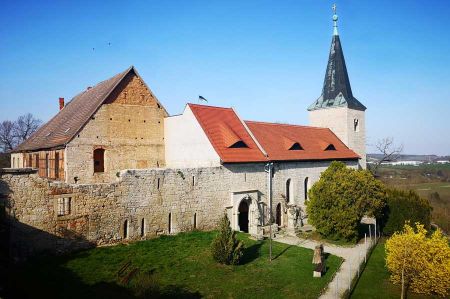Zscheiplitz Monastery - a stopover on Unstrut cycle path
- Written by Portal Editor
The place Zscheiplitz is located on the elevated left bank of the Unstrut within sight of the Neuchâtel / Neuenburg about two kilometers west of Freyburg in southern Saxony-Anhalt.
With our HNF bikes we had followed a section of the so-called Radacht from Eckardsberger via Bad Kösen and the course of the Saale, then via Freyburg following the Unstrut to the foot of the monastery, which can already be seen from Freyburg and from the opposite direction from Laucha is.
The first written mention of the place dates back to the year 1085. The name Sciplice mentioned there suggests a Slavic foundation of the place. From 1041 to 1085 Count Palatine Friedrich III lived here in a residence called Weissenburg Castle of Saxony. After his murder, the castle was converted into the Benedictine monastery of St. Bonifacius on St. Martini's mountain in 1089 by Friedrich's widow, Adelheid († 1110), who had meanwhile married Ludwig the Springer.
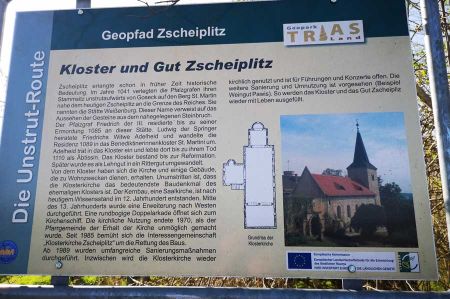 The monastery was abolished in the course of secularization in 1540 and converted into a knight's manor, which was expropriated in the course of the land reform in 1945.
The monastery was abolished in the course of secularization in 1540 and converted into a knight's manor, which was expropriated in the course of the land reform in 1945.
Until 1815 the place belonged to the Wettin, later Electoral Saxon office of Freyburg. In 1813 Napoléon Bonaparte had the place occupied by his troops in order to secure the retreat after their defeat in the Battle of the Nations near Leipzig when crossing the Unstrut. As a result of the resolutions of the Congress of Vienna, Zscheiplitz became part of Prussia and in 1816 was assigned to the Querfurt district in the Merseburg administrative district of the province of Saxony, to which it belonged until 1944.
Monastery and Church - St. Bonifatius and Water Tower
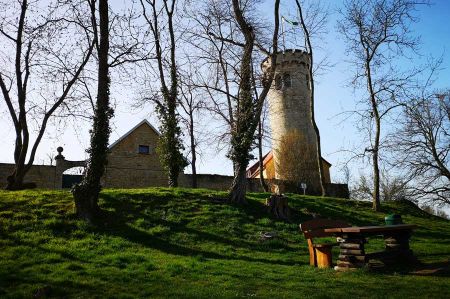 Regular concerts are held in the St. Bonifatius monastery church of the former medieval Benedictine monastery, which has been renovated since 1985 by the Zscheiplitz Monastery Church Organisation (IGZ) (from 1995: Monastery Zscheiplitz - Klosterbrüder e.V.). At night the church is illuminated from the outside and can be seen from a great distance.
Regular concerts are held in the St. Bonifatius monastery church of the former medieval Benedictine monastery, which has been renovated since 1985 by the Zscheiplitz Monastery Church Organisation (IGZ) (from 1995: Monastery Zscheiplitz - Klosterbrüder e.V.). At night the church is illuminated from the outside and can be seen from a great distance.
A winery on the site of the former manor offers an ostrich farm four months a year in addition to wine tasting. The owner family has presented exhibitions in the manor house of the manor since 2015.
In the immediate vicinity of the property is the water tower, which was built as a lookout tower in 1866 and can be climbed. It offers a wide view of the Unstruttal, the Zeddenbachmühle, the Neuchâtel / Neuenburg and the Balgstädt Castle.
At the time of the GDR - an almost impossible undertaking
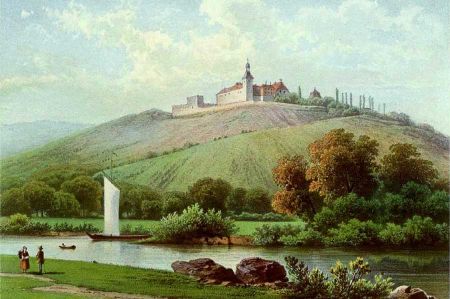 The Zscheiplitz Monastery - Klosterbrüder e. V. are a non-profit association registered since 1995, which was founded in early 1985 with the name of Interest Group Klosterkirche Zscheiplitz (IGZ) by about a dozen citizens from Zscheiplitz with the aim of building the decaying medieval former monastery church of the former Benedictine monastery Zscheiplitz in the village to be restored and made accessible again. The main restoration work was carried out by the IGZ during the GDR era.
The Zscheiplitz Monastery - Klosterbrüder e. V. are a non-profit association registered since 1995, which was founded in early 1985 with the name of Interest Group Klosterkirche Zscheiplitz (IGZ) by about a dozen citizens from Zscheiplitz with the aim of building the decaying medieval former monastery church of the former Benedictine monastery Zscheiplitz in the village to be restored and made accessible again. The main restoration work was carried out by the IGZ during the GDR era.
This form of a private, non-state-controlled citizens' initiative was extremely unusual in the times of the GDR for several reasons: the establishment was not formally legitimized, the reconstruction of a church was not necessarily wanted by the GDR state and the citizens of Zscheiplitz organized completely privately without direct support from a political party or the city administration.
In spite of this, the IGZ was tacitly recognized by the authorities responsible for monument protection and the representation of the Evangelical Church of Anhalt in the course of the following months, not least due to a very clever negotiating tactic. In the spring of 1985, a "user agreement" was concluded with the church, which gave the interest group direct permission to carry out all necessary measures for the reconstruction of the monastery church on behalf of the church. The legal construction was probably unique in the GDR.
Even after the fall of the Wall in 1989, contrary to all formal legal requirements, the all-German authorities continued to grant the interest group all responsibilities for measures to reconstruct the monastery church. This also included the acceptance and administration of all funds.
Emergency backup by the association Kloster Tscheiplitz - Klosterbrüder e.V.
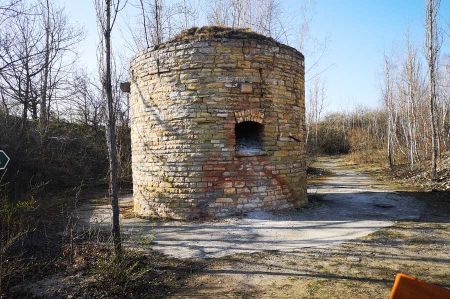 In the years 1985 to 1989, the IGZ initiated an emergency safeguarding and clearing of the area from rubbish and wild growth, a renewal of the entire roof structure including the false ceiling and the roof covering of the church nave, the renovation of the church tower with reconditioning of the damaged wooden structure and new roofing Sheet copper so that the monastery church can be used again for church services, concerts and exhibitions. Further construction measures such as interior plastering, the construction of a wooden gallery, new electrics, the complete reconstruction of the lead glass windows as well as exterior lighting that can be seen from afar were carried out by the IGZ and the association successively and largely through the personal commitment of the association members. The association was repeatedly supported by donations in money and in kind from private individuals and local companies.
In the years 1985 to 1989, the IGZ initiated an emergency safeguarding and clearing of the area from rubbish and wild growth, a renewal of the entire roof structure including the false ceiling and the roof covering of the church nave, the renovation of the church tower with reconditioning of the damaged wooden structure and new roofing Sheet copper so that the monastery church can be used again for church services, concerts and exhibitions. Further construction measures such as interior plastering, the construction of a wooden gallery, new electrics, the complete reconstruction of the lead glass windows as well as exterior lighting that can be seen from afar were carried out by the IGZ and the association successively and largely through the personal commitment of the association members. The association was repeatedly supported by donations in money and in kind from private individuals and local companies.
The importance of the activities of the IGZ and the later association can be seen in 2011 from the fact that through the Förderverein Welterbe an Saale und Unstrut e. V., it was proposed to put the former monastery church, which was completely restored through a purely private initiative, on the UNESCO World Heritage List.
Interesting not only for geologists: the Zscheiplitz Monastery Geopath leads you, among other things, to a former lime kiln.
Please read as well:
Cycling - Joining the Saale-Unstrut-Elster-Rad-Eight
Danube Cycle Path - Vienna Region is one of highlights
-
 Tscheiplitz Monastery at Unstrut Bike Route
Tscheiplitz Monastery at Unstrut Bike Route
Tscheiplitz Monastery at Unstrut Bike Route
Tscheiplitz Monastery at Unstrut Bike Route
-
 Tscheiplitz Monastery at Unstrut Bike Route
Tscheiplitz Monastery at Unstrut Bike Route
Tscheiplitz Monastery at Unstrut Bike Route
Tscheiplitz Monastery at Unstrut Bike Route
-
 Tscheiplitz Monastery at Unstrut Bike Route
Tscheiplitz Monastery at Unstrut Bike Route
Tscheiplitz Monastery at Unstrut Bike Route
Tscheiplitz Monastery at Unstrut Bike Route
-
 Tscheiplitz Monastery at Unstrut Bike Route
Tscheiplitz Monastery at Unstrut Bike Route
Tscheiplitz Monastery at Unstrut Bike Route
Tscheiplitz Monastery at Unstrut Bike Route
-
 Tscheiplitz Monastery at Unstrut Bike Route
Tscheiplitz Monastery at Unstrut Bike Route
Tscheiplitz Monastery at Unstrut Bike Route
Tscheiplitz Monastery at Unstrut Bike Route
-
 Tscheiplitz Monastery at Unstrut Bike Route
Tscheiplitz Monastery at Unstrut Bike Route
Tscheiplitz Monastery at Unstrut Bike Route
Tscheiplitz Monastery at Unstrut Bike Route
-
 Tscheiplitz Monastery at Unstrut Bike Route
Tscheiplitz Monastery at Unstrut Bike Route
Tscheiplitz Monastery at Unstrut Bike Route
Tscheiplitz Monastery at Unstrut Bike Route
-
 Tscheiplitz Monastery at Unstrut Bike Route
Tscheiplitz Monastery at Unstrut Bike Route
Tscheiplitz Monastery at Unstrut Bike Route
Tscheiplitz Monastery at Unstrut Bike Route
-
 Tscheiplitz Monastery at Unstrut Bike Route
Tscheiplitz Monastery at Unstrut Bike Route
Tscheiplitz Monastery at Unstrut Bike Route
Tscheiplitz Monastery at Unstrut Bike Route
https://www.alaturka.info/en/germany/saxony-anhalt/5342-zscheiplitz-monastery-a-stopover-on-the-unstrut-cycle-path#sigProId7d45bd2e67
